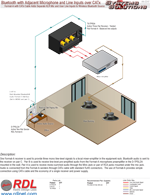
Description:
All audio processing in this briefing room is handled by a centrally located Dante-enabled DSP. The RDL DD-BN2M Bi-Directional Mic/Line Interface connects the two microphones and the two permanently installed D-PSP1 Decora-Style Active Loudspeakers to the Dante network. Each D-PSP1 serves as a near-field monitor and is fed from the line-level outputs on the rear of the DD-BN2M. Each XLR input provides three switches that are set from the front of the unit before the cover plate is installed. One switch enables or disables P48 phantom; the second switch selects the mic or line gain range; the third switch sets the gain.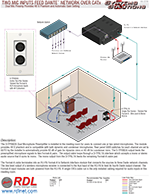
TWO MIC INPUTS FEED DANTE™ NETWORK OVER CATx
Dual Mic Preamp Provides 48 V Phantom and Automatic Gain Setting
AN-2239
Description:
The D-TPSM2A Dual Microphone Preamplifier is installed in the meeting room for users to connect one or two wired microphones. The module provides 48 V phantom and is compatible with both dynamic and condenser microphones. Rear panel GAIN switches for each channel are set to AUTO by the installer to automatically provide 60 dB of gain for dynamic mics or 40 dB for condenser mics. The D-TPSM2A output feeds the preamplified microphone signals to two Format-A pairs. The output cable loops through a D-TPSL1A interface which accepts a mono or stereo audio source that it sums to mono. The mono output from the D-TPSL1A feeds the remaining Format-A cable pair. The Format-A cable terminates into an RU-FN Format-A to Network Interface module that converts the sources to three Dante network channels. The line-level output of a wireless microphone receiver is connected to the Aux Input of the RU-FN to feed its fourth Dante output channel. The Format-A input modules are both powered from the RU-FN. A single CATx cable run is the only installed cabling required for audio inputs in this meeting room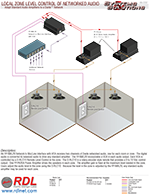
LOCAL ZONE LEVEL CONTROL OF NETWORKED AUDIO
Adapt Standard Audio Amplifiers to a Dante&trade Network
AN-2237
Description:
An FP-NML2V Network to Mic/Line Interface with VCA receives two channels of Dante networked audio, one for each room or zone. The digital audio is converted to balanced audio to drive any standard amplifier. The FP-NML2V incorporates a VCA in each audio output. Each VCA is controlled by a D-RLC10 Remote Level Control in the zone. The D-RLC10 is a rotary encoder style remote that provides a 0 to 10 Vdc control output. One FP-PA35A Power Amplifier drives the speakers in each zone. The amplifier gain is fixed at the maximum level needed in the zone. Users adjust the audio level in the zone using the D-RLC10. Because the level in the zone is adjusted by the FP-NML2V, any standard audio amplifier may be used for each zone.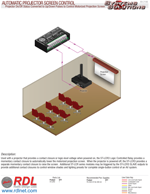
AUTOMATIC PROJECTOR SCREEN CONTROL
Projector On/Off Status Converted to Up/Down Pulses to Control Motorized Projection Screen
AN-2186
Description:
Used with a projector that provides a contact closure or logic-level voltage when powered on, the ST-LCR3 Logic Controlled Relay provides a momentary contact closure to automatically lower the motorized projection screen. When the projector is powered off, the ST-LCR3 provides a separate momentary contact closure to raise the screen. Additional ST-LCR series modules may be triggered by the ST-LCR3 SLAVE outputs to provide additional contact closures to control window shades and lighting presets for complete single-button control of an AV system.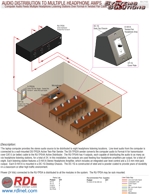
AUDIO DISTRIBUTION TO MULTIPLE HEADPHONE AMPS
Computer Audio Feeds Multiple Headphone Listening Stations Over Format-A Twisted Pair Cable
AN-2163
Description:
The laptop computer provides the stereo audio source to be distributed to eight headphone listening locations. Line-level audio from the computer is connected to a wall-mounted DS-TPS2A Active Two-Pair Sender. The DS-TPS2A sender converts the computer audio to Format-A for transmission over CAT-5 (or better) cable to the RU-TPS4A Active Distributor. The RU-TPS4A has 4 outputs, each capable of distributing the audio to as many as six headphone listening stations, for a total of 24. In this installation, two outputs are used feeding four headphone amplifiers per output, for a total of eight. Each listening station features a D-HA1A Stereo Headphone Amplifier, which includes an integrated user level control and a 3.5 mm mini-jack output. Each D-HA1A is mounted in a DC-1G Desktop Chassis. The DC-1G is constructed of steel and is powder coated to provide years of durability in a classroom or other high traffic environment. Power (24 Vdc) connected to the RU-TPDA is distributed to all the modules in the system. The RU-TPDA may be rack mounted.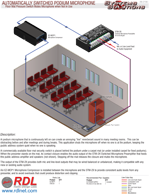
AN-2156
Description:
A podium microphone that is continuously left on can create an annoying “live” reverberant sound in many meeting rooms. This can be distracting before and after meetings and during breaks. This application shuts the microphone off when no one is at the podium, keeping the public address system quiet when no one is speaking. A commercially available floor mat security switch is placed behind the podium under a carpet mat (or under installed carpet for fixed podiums). When the presenter stands on the mat, its contact closure enables the audio output of the STM-2X Switched Microphone Preamplifier that feeds the public address amplifier and speakers (not shown). Stepping off the mat releases the closure and mutes the microphone. The output of the STM-2X provides both mic and line-level outputs that may be wired balanced or unbalanced, making it compatible with any new or existing audio system. An EZ-MCP1 Microphone Compressor is installed between the microphone and the STM-2X to provide consistent audio levels from any presenter, and to avoid overloads that could produce distortion and clipping.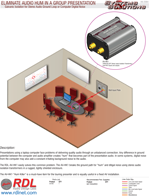
ELIMINATE AUDIO HUM IN A GROUP PRESENTATION
Galvanic Isolation for Stereo Audio Ground Loop or Computer Digital Noise
AN-2084
Description:
Presentations using a laptop computer face problems of delivering quality audio through an unbalanced connection. Any difference in ground potential between the computer and audio amplifier creates “hum” that becomes part of the presentation audio. In some systems, digital noise from the computer may also add a constant irritating background noise to the audio. The RDL AV-HK1 easily solves this common problem. The AV-HK1 breaks the ground path for “hum” and Digital noise using stereo audio isolation transformers in a rugged, tightly shielded enclosure. The AV-HK1 “Hum Killer” is a must-have item for the touring presenter and is equally useful in a fixed AV installation.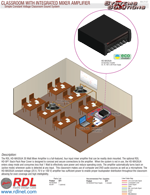
Description:
The RDL HD-MA35UA 35 Watt Mixer Amplifier is a full-featured, four input mixer amplifier that can be readily desk mounted. The optional RDL HD-BP1 Back-Pack Rear Cover is designed to conceal and secure connections to the amplifier. When the system is not in use, the HD-MA35UA enters sleep mode and consumes less that 1 Watt to effectively save power and reduce operating costs. The amplifier automatically turns back on (active mode) whenever audio is detected at any input. This classroom makes use of computer and DVD audio sources as well as a microphone. The HD-MA35UA constant voltage (25 V, 70 V or 100 V) amplifier has sufficient power to enable proper loudspeaker distribution throughout the classroom allowing for even coverage and high intelligibility.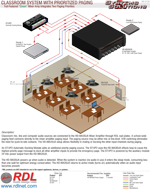
CLASSROOM SYSTEM WITH PRIORITIZED PAGING
Full-Featured “Green†Mixer Amp Integrates Two Paging Priorities
AN-2133
Description:
Classroom mic, line and computer audio sources are connected to the HD-MA35UA Mixer Amplifier through RDL wall plates. A school-wide paging feed connects directly to the mixer amplifier paging input. The paging source may be either mic or line level. VOX switching eliminates the need for push-to-talk contacts. The HD-MA35UA setup allows flexibility in muting or ducking the other input channels during paging. An ST-VP2 Automatic Ducking Module adds an additional priority paging source. The ST-VP2 uses the HD-MA35UA effects loop to cause the highest priority page message to duck all other amplifier inputs to provide the emergency page. The ST-VP2 is powered by the auxiliary module 24 Vdc power output from the HD-MA35UA. The HD-MA35UA powers up when audio is detected. When the system is inactive (no audio in use) it enters the sleep mode, consuming less than one watt for optimum energy conservation. The HD-MA35UA returns to active mode (turns on) automatically when an audio input becomes present.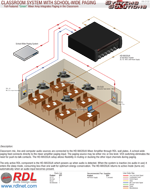
CLASSROOM SYSTEM WITH SCHOOL-WIDE PAGING
Full-Featured “Green†Mixer Amp Integrates Paging in the Classroom
AN-2132
Description:
Classroom mic, line and computer audio sources are connected to the HD-MA35UA Mixer Amplifier through RDL wall plates. A school-wide paging feed connects directly to the mixer amplifier paging input. The paging source may be either mic or line level. VOX switching eliminates the need for push-to-talk contacts. The HD-MA35UA setup allows flexibility in muting or ducking the other input channels during paging. The only active RDL component is the HD-MA35UA which powers up when audio is detected. When the system is inactive (no audio in use) it enters the sleep mode, consuming less than one watt for optimum energy conservation. The HD-MA35UA returns to active mode (turns on) automatically when an audio input becomes present.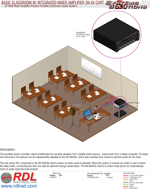
BASIC CLASSROOM W/ INTEGRATED MIXER AMPLIFIER ON AV CART
35 Watt Mixer Amplifier Powers Portable Classroom Audio System
AN-2131
Description:
This portable system provides robust amplification for portable speakers from multiple audio sources. Audio levels from a laptop computer, CD player and instructor’s microphone can be independently adjusted on the HD-MA35U, which also provides tone control to optimize audio for the room. The only active RDL component is the HD-MA35U which powers up when audio is detected. When the system is inactive (no audio in use) it enters the sleep mode, consuming less than one watt for optimum energy conservation. The HD-MA35U returns to active mode (turns on) automatically when an audio input becomes present.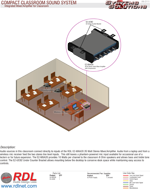
Description:
Audio sources in this classroom connect directly to inputs of the RDL EZ-MXA20 20 Watt Stereo Mixer/Amplifier. Audio from a laptop and from a wireless mic receiver feed the two stereo line level inputs. This still leaves a phantom-powered mic input available for occasional use of a lectern or for future expansion. The EZ-MXA20 provides 10 Watts per channel to the classroom 8 Ohm speakers and allows bass and treble tone control. The EZ-UCB2 Under Counter Bracket allows mounting below the desktop to conserve desk space while maintaining easy access to controls.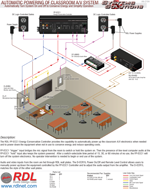
AUTOMATIC POWERING OF CLASSROOM A/V SYSTEM
Automatically Turn System On and Off to Conserve Energy and Simplify Operation
AN-2104
Description:
The RDL FP-ECC1 Energy Conservation Controller provides the capability to automatically power up the classroom A/V electronics when needed and to power down the equipment when not in use to conserve energy and reduce operating costs. FP-ECC1 “trigger” input bridges the mic signal from the room to switch or hold the system on. Then the presence of line-level computer audio at the FP-ECC1 “hold” input also keeps the system powered. After a switch-selectable time period of 15, 30, or 60 minutes of no use, the FP-ECC1 will turn off the system electronics. No operator intervention is needed to begin or end use of the system. Audio and video inputs from the room are fed through RDL wall plates. The D-ECR1L Power On/Off and Remote Level Control allows users to manually power up/down the equipment controlled by the FP-ECC1 Controller and to adjust the audio output from the amplifier. The D-ECR1L matches the style of the other wall plates.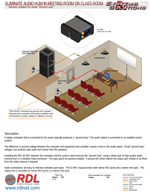
AN-2096
Description:
A laptop computer that is connected to AC power typically produces a “ground loop” if its audio output is connected to an installed sound system. The difference in ground voltage between the computer and equipment rack amplifier causes a hum in the audio signal. Small “ground loop” voltages can produce high audio hum levels from the speakers. Installing the RDL EZ-HK1 between the computer and the system input removes the “ground loop” using a stereo pair of high quality audio transformers in a shielded metal enclosure. The input jacks are ground-isolated. A ground-lift switch allows the output jack shields to be lifted from the metal chassis if required. Audio connections are easy to interface between jack types. The EZ-HK1 input provides both stereo RCA jacks and a stereo mini-jack. The output also is provided on stereo RCA jacks or a stereo mini-jack.
ELIMINATE AUDIO AND VIDEO HUM IN CLASS ROOM
Galvanic Isolation for Audio and Composite Video “Ground Loopsâ€
AN-2101
Description:
Picture and sound quality from the player on the equipment cart is easily degraded by a “ground loop”. The difference in ground voltage between the audio/video source and monitoring locations can create herringbone or rolling hum bars in the video, and hum in the audio. Small “ground loop” voltages can easily impair the quality of audio and/or video signals. The RDL EZ-HK3 removes the “ground loop” using a stereo pair of high quality audio and video transformers in a shielded metal enclosure. The input jacks are ground-isolated. A ground-lift switch allows the output jack shields to be lifted from the metal chassis if required.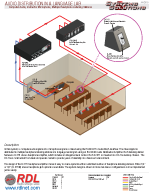
AUDIO DISTRIBUTION IN A LANGUAGE LAB
Computer Audio, Instructor Microphone, Multiple Headphone Listening Stations
AN-2019
Description:
In this system, a computer audio signal and a microphone signal are mixed using the RU-MX4 Pro Audio Mic/Line Mixer. The mixed signal is distributed to multiple headphone listening stations in a language learning lab using an RU-ADA4D Audio Distribution Amplifier. Each listening station features a D-SH1 stereo headphone amplifier, which includes an integrated level control. Each D-SH1 is mounted in a DC-1G desktop chassis. The DC-1G is constructed from steel and powder coated to provide years of durability in a classroom environment. The design of the D-SH1 headphone amplifier makes it easy to create systems with an unlimited number of headphone listening stations. Either 1/4″ or 1/8″ (D-SH1M) stereo headphone jack options are available. The system design is shown in mono but stereo configurations can be implemented just as easily.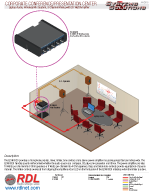
CORPORATE CONFERENCE/PRESENTATION CENTER
Laptop Audio, Wireless Mic System, 3 Channel Mixing with 20 Watt Amplifier
AN-2018
Description:
The EZ-MXA20 provides a microphone preamp, mixer, limiter, tone control, and a stereo power amplifier in a package less than six inches wide. The EZ-MXA20 handles sound reinforcement whether the audio source is a computer, CD player, live presenter or all three. The power amplifier provides 10 Watts per channel into 8 Ohm speakers or 8 Watts per channel into 4 Ohm speakers. Bass and treble tone controls provide equalization of source material. The limiter controls overloads from clipping the amplifier and an LED on the front panel of the EZ-MXA20 indicates when the limiter is active.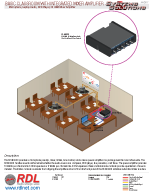
BASIC CLASSROOM WITH INTEGRATED MIXER AMPLIFIER
Microphone, Laptop Audio, DVD Player, 20 Watt Mixer Amplifier
AN-2017
Description:
The EZ-MXA20 provides a microphone preamp, mixer, limiter, tone control, and a stereo power amplifier in a package less than six inches wide. The EZ-MXA20 handles sound reinforcement whether the audio source is a computer, DVD player, live presenter, or all three. The power amplifier provides 10 Watts per channel into 8 Ohm speakers or 8 Watts per channel into 4 Ohm speakers. Bass and treble tone controls provide equalization of source material. The limiter controls overloads from clipping the amplifier and an LED on the front panel of the EZ-MXA20 indicates when the limiter is active.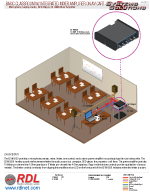
BASIC CLASSROOM W/ INTEGRATED MIXER AMPLIFIER ON AV CART
Microphone, Laptop Audio, DVD Player, 20 Watt Mixer Amplifier
AN-2015
Description:
The EZ-MXA20 provides a microphone preamp, mixer, limiter, tone control, and a stereo power amplifier in a package less than six inches wide. The EZ-MXA20 handles sound reinforcement whether the audio source is a computer, DVD player, live presenter, or all three. The power amplifier provides 10 Watts per channel into 8 Ohm speakers or 8 Watts per channel into 4 Ohm speakers. Bass and treble tone controls provide equalization of source material. The limiter controls overloads from clipping the amplifier and an LED on the front panel of the EZ-MXA20 indicates when the limiter is active.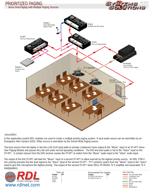
Description:
In this application several RDL modules are used to create a multiple priority paging system. A local audio source can be overridden by an Emergency Alert System (EAS). Either source is overridden by the School Wide Paging source. The local source from the laptop is fed into a DS-CIJ3 input plate to provide a balanced mono output to the “Music” input of an ST-VP1 Voice- Over Paging Module and passes thru the unit under normal operating conditions. The EAS line level audio is fed to the “Voice” input on the ST-VP1. A contact closure from the EAS receiver causes the ST-VP1 to switch from the “Music” audio input to the “Voice” audio input. The output of the first ST-VP1 will feed the “Music” input of a second ST-VP1 to allow override by the highest priority source. An RDL STM-2 mic preamp provides the line level signal to the “Voice” input of the second ST-VP1. PTT contacts switch from the “Music” input to the “Voice” input to give this microphone the highest priority. The output of the second ST-VP1 feeds RDL’s FP-PA20A 70 V amplifier and associated 70 V loudspeakers.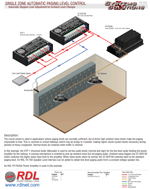
SINGLE ZONE AUTOMATIC PAGING LEVEL CONTROL
Automatic Stepped Level Adjustment for Ambient Level Changes
AN-2034
Description:
The circuit shown is ideal in applications where paging levels are normally sufficient, but at times high ambient noise levels make the paging impossible to hear. This is common in school hallways which may be empty or crowded, making higher sound system levels necessary during periods of heavy congestion. Normal levels are restored when traffic is minimal. In this example, the STP-1 Universal Audio Attenuator is used to set two audio levels (normal and high) for the line-level audio feeding the power amplifier for the hallway. A sensing microphone is oriented to pick up ambient noise but not paging audio. Ambient noise triggers the ST-ACR1M which switches the higher audio input level to the amplifier. When noise levels return to normal, the ST-ACR1M switches back to the standard paging level. An RDL TX-70A Speaker Level Interface can be added to obtain line-level paging audio from a constant voltage speaker line.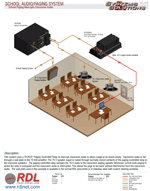
Description:
This system uses a TX-PCR1 Paging Controlled Relay to interrupt classroom audio to allow a page to be heard clearly. Classroom audio is fed through a wall plate to the 70 Volt amplifier. The 70 V speaker ouput is routed through normally closed contacts of the paging controlled relay to the clasroom speakers. The paging controlled relay samples the 70 V audio to the classroom paging speaker. Whenever school-wide paging is active the relay is energized and the classroom audio is interrupted. This allows the page to be heard without interference from the classroom audio. The wall plate used in this example is available in the normal RDL grey/white or in stainless steel with custom labeling available.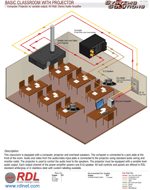
BASIC CLASSROOM WITH PROJECTOR
Computer, Projector w/ variable output, 40 Watt Stereo Audio Amplifier
AN-2049
Description:
This classroom is equipped with a computer, projector and overhead speakers. The computer is connected to a jack plate at the front of the room. Audio and video from the audio/video input plate is connected to the projector using standard audio wiring and monitor cable. The projector is used to control the audio level to the speakers. The projector must be equipped with a variable level audio output. Each output channel of the power amplifier powers one 8 Ω speaker. All wall controls and panels are offered in RDL standard white/gray or in stainless steel with custom labeling available.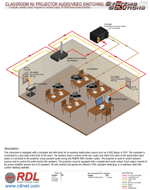
CLASSROOM W/ PROJECTOR AUDIO/VIDEO SWITCHING
Computer, Auxiliary Input, Projector w/ variable output, 40 Watt Stereo Audio Amplifier
AN-2048
Description:
This classroom is equipped with a computer and with jacks for an auxiliary audio/video source such as a DVD player or VCR. The computer is connected to a jack plate at the front of the room. The auxiliary input is shown at the rear. Audio and video from each of the audio/video input plates is connected to the projector using standard audio wiring and monitor cables. The projector is used to switch between sources and to control the audio level to the speakers. The projector must be equipped with a variable level audio output. Each output channel of the power amplifier powers two 8 Ω speakers. All wall controls and panels are offered in RDL standard white/gray or in stainless steel with custom labeling available.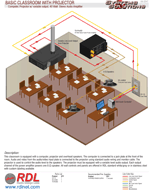
BASIC CLASSROOM WITH PROJECTOR
Computer, Projector w/ variable output, 40 Watt Stereo Audio Amplifier
AN-2047
Description:
This classroom is equipped with a computer, projector and overhead speakers. The computer is connected to a jack plate at the front of the room. Audio and video from the audio/video input plate is connected to the projector using standard audio wiring and monitor cable. The projector is used to control the audio level to the speakers. The projector must be equipped with a variable level audio output. Each output channel of the power amplifier powers one 8 Ω speaker. All wall controls and panels are offered in RDL standard white/gray or in stainless steel with custom labeling available.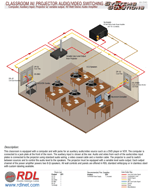
CLASSROOM W/ PROJECTOR AUDIO/VIDEO SWITCHING
Computer, Auxiliary Input, Projector w/ variable output, 40 Watt Stereo Audio Amplifier
AN-2046
Description:
This classroom is equipped with a computer and with jacks for an auxiliary audio/video source such as a DVD player or VCR. The computer is connected to a jack plate at the front of the room. The auxiliary input is shown at the rear. Audio and video from each of the audio/video input plates is connected to the projector using standard audio wiring and monitor cables. The projector is used to switch between sources and to control the audio level to the speakers. The projector must be equipped with a variable level audio output. Each output channel of the power amplifier powers two 8 Ω speakers. All wall controls and panels are offered in RDL standard white/gray or in stainless steel with custom labeling available.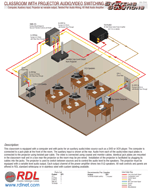
CLASSROOM WITH PROJECTOR AUDIO/VIDEO SWITCHING
Computer, Auxiliary Input, Projector w/ variable output, Twisted Pair Audio Wiring, 40 Watt Audio Amplifier
AN-2045
Description:
This classroom is equipped with a computer and with jacks for an auxiliary audio/video source such as a DVD or VCR player. The computer is connected to a jack plate at the front of the room. The auxiliary input is shown at the rear. Audio from each of the audio/video input plates is connected to the projector using twisted-pair cable. The video is connected using coaxial and monitor cables. Identical jack plates are mounted in the classroom wall and in a box near the projector so the room may be pre-wired. Installation of the projector is facilitated by plugging its cables into the jacks. The projector is used to switch between sources and to control the audio level to the speakers. The projector must be equipped with a variable level audio output. Each output channel of the power amplifier powers two 8 Ω speakers. All wall controls and panels are offered in RDL standard white/gray or in stainless steel with custom labeling available.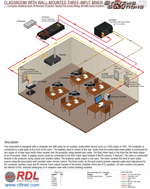
CLASSROOM WITH WALL-MOUNTED THREE-INPUT MIXER
Computer, Auxiliary Input, IR Receiver, Projector, Twisted Pair Audio Wiring, 40 Watt Audio Amplifier
AN-2044
Description:
This classroom is equipped with a computer and with jacks for an auxiliary audio/video source such as a DVD player or VCR. The computer is connected to a jack plate at the front of the room. The auxiliary input is shown at the rear. Audio from the audio/video input plates is connected to two inputs of a three input audio mixer located near the projector using twisted-pair cable. The third mixer input is fed from the line-level output of an IR receiver. (Note: A paging source could be connected to the third mixer input instead of the IR receiver, if desired.) The video is connected directly to the projector using coaxial and monitor cables. The projector audio output is not used. The mixer controls the level of each audio source using the associated wall mounted mixer remote control. The three knobs on the wall control provide separate audio level adjustment for the computer, auxiliary input and IR receiver. Each output channel of the power amplifier powers two 8 Ω speakers. All wall controls and panels are offered in RDL standard white/gray or in stainless steel with custom labeling available.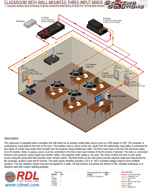
CLASSROOM WITH WALL-MOUNTED THREE-INPUT MIXER
Computer, Auxiliary Input, IR Receiver, Projector, Twisted Pair Audio Wiring, 20 Watt 70 or 100 Volt Audio Amplifier
AN-2043
Description:
This classroom is equipped with a computer and with jacks for an auxiliary audio/video source such as a DVD player or VCR. The computer is connected to a jack plate at the front of the room. The auxiliary input is shown at the rear. Audio from the audio/video input plates is connected to two inputs of a three input audio mixer located near the projector using twisted-pair cable. The third mixer input is fed from the line-level output of an IR receiver. (Note: A paging source could be connected to the third mixer input instead of the IR receiver, if desired.) The video is connected directly to the projector using coaxial and monitor cables. The projector audio output is not used. The mixer controls the level of each audio source using the associated wall mounted mixer remote control. The three knobs on the wall control provide separate audio level adjustment for the computer, auxiliary input and IR receiver. The audio power amplifier provides a 70 V and 100 V constant-voltage output to power multiple speakers. The four speakers shown may each be tapped for 5 watts. All wall controls and panels are offered in RDL standard white/gray or in stainless steel with custom labeling available.